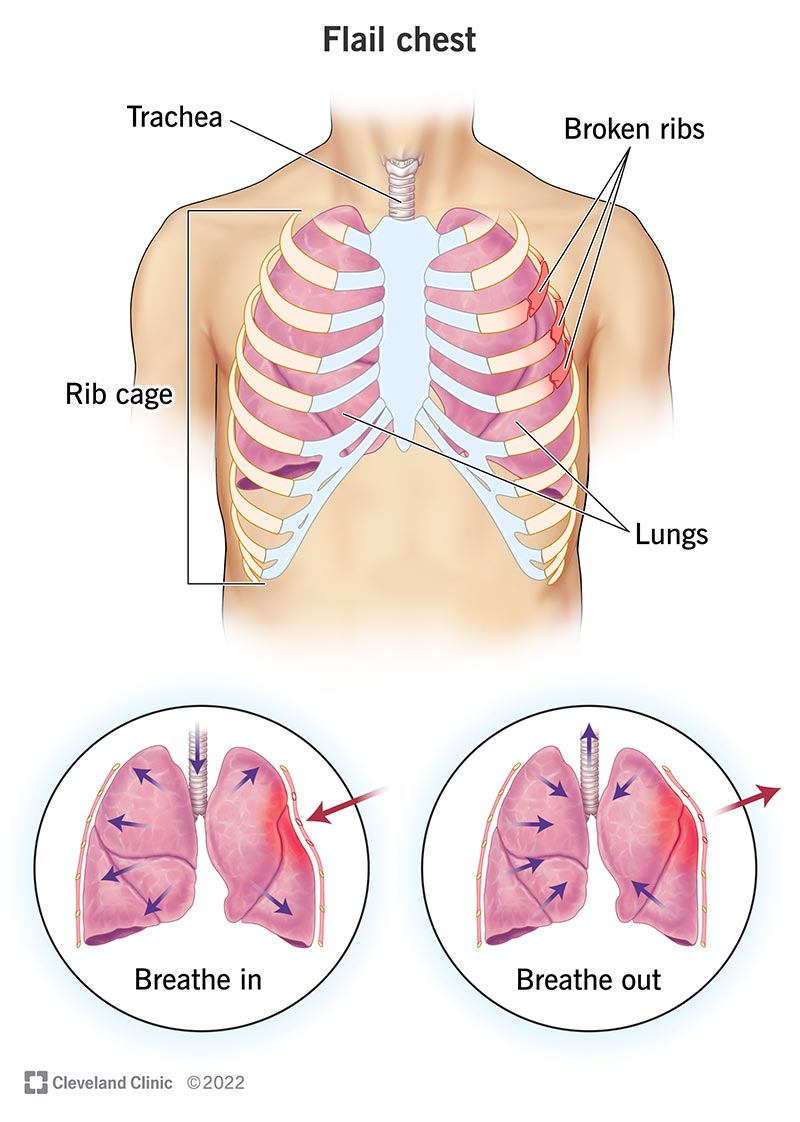Flail chest is a medical emergency that happens as a result of a trauma. Due to 3 or more ribs broken in 2 or more places, your chest wall becomes unstable. You’re in pain and can’t breathe deeply.
Advertisement
Cleveland Clinic is a non-profit academic medical center. Advertising on our site helps support our mission. We do not endorse non-Cleveland Clinic products or services. Policy

Flail chest is a medical emergency. It’s life-threatening. It’s very painful.
Advertisement
Cleveland Clinic is a non-profit academic medical center. Advertising on our site helps support our mission. We do not endorse non-Cleveland Clinic products or services. Policy
Flail chest is a traumatic disorder that happens when three or more ribs located next to each other are fractured in two or more places. This causes your chest wall to become unstable, interfering with breathing.
The fractures cause your ribs and chest wall to malfunction in the ways they move. This movement, called paradoxical, means the injured section of your chest wall moves in an opposite direction when compared with your undamaged chest wall.
Flail chest may also be called chest wall instability or deformity.
The risk factors for flail chest are similar to risk factors for major trauma. Flail chest tends to happen to people who:
You may show the following signs and symptoms of flail chest:
The primary cause of flail chest is trauma, mainly motor vehicle accidents. The next most common cause is falls in older people who may have osteoporosis.
Your healthcare provider will diagnose flail chest mainly by observing your breathing. The breaks in your ribs show up when you breathe in and out. The line of your chest will pop out more during exhaling and go in farther during inhaling if you have flail chest.
Advertisement
Your healthcare provider may order chest X-rays. These will show bone breaks but not changes in cartilage. Chest X-rays are also likely to show bruises to your lung.
Your provider may also touch (palpate) you and be able to feel that you have broken ribs.
At first, you’ll get oxygen and be monitored. You’ll be medicated for pain if you have flail chest to make sure the pain doesn’t interfere with your breathing. Your healthcare team will also perform pulmonary hygiene measures to keep your airways clear of secretions.
You may receive intravenous (IV) medications, an epidural or intercostal pain blocks to relieve your pain. Your provider may combine approaches.
Pulmonary hygiene is a term used for exercises and procedures that keep your lungs clear of secretions. Your providers will work to keep you from developing pneumonia, which is the main complication of flail chest. Pulmonary hygiene is also known as pulmonary toilet or chest physiotherapy and may include:
Your provider may use continuous airway positive pressure (CPAP) or supplemental oxygen instead of mechanical ventilation to help you breathe. You may have to be on a ventilator to help you breathe until the trauma heals.
You may have to have surgery to prevent complications such as pneumonia, very long hospital stays or even death. This surgery is known as surgical rib fixation. There are various types of implanted devices used to keep your ribs stable.
After you begin recovering, you’ll still need to follow some suggestions for pulmonary hygiene. This may include breathing exercises such as pursed lip breathing and diaphragmatic (belly) breathing, along with ways of positioning your body.
If you have flail chest, you can expect to spend time in the hospital. Some studies have shown your length of stay in the intensive care unit (ICU) and in the hospital can be lower if you have surgical rib fixation.
It can take months to recover from flail chest and the trauma that caused it. You may continue to have difficulty breathing even after you’ve left the hospital.
You may reduce your risk of flail chest by reducing your risk of trauma. Drive safely, and always use your seat belt.
If you’re at risk of falling, make sure your floors are clear, you have enough light and you always use any walking aids you need, such as a walker or a cane.
Advertisement
You can expect to be in the hospital for some time if you have flail chest. You may not be able to take care of yourself for a while.
When you’re able to do so, you should follow the suggestions of your healthcare provider regarding breathing exercises, controlled coughing and other methods of reducing secretion buildup in your lungs.
No. Flail chest and pneumothorax aren’t the same thing.
A pneumothorax is also called a collapsed lung. The air goes between your chest wall and your lung rather than into your lung. You may have a pneumothorax as a complication of flail chest.
Flail chest is very serious. It can be fatal. It must be treated medically.
Flail chest is a life-threatening medical emergency that happens as a result of trauma. If you have flail chest, it will take some time to recover. You'll be in the hospital for a long time. You may be on a ventilator for days. Even after you begin to recover, you’ll need to continue breathing exercises.
Advertisement
Breathing issues can affect your life in many ways. Cleveland Clinic’s respiratory therapy program treats your symptoms so you can feel better day to day.

Last reviewed on 08/16/2022.
Learn more about the Health Library and our editorial process.